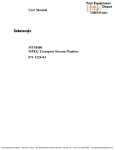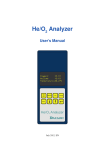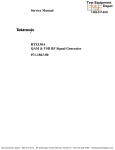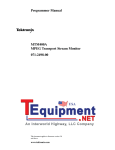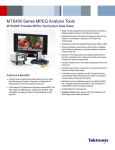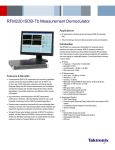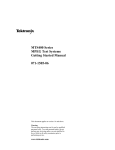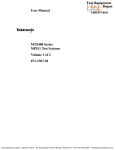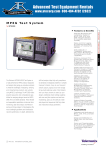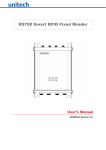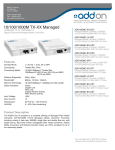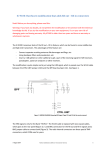Download MTM400A, IPM400A, and RFM300 DTV Monitors
Transcript
xx ZZZ MTM400A, IPM400A, and RFM300 DTV Monitors Specifications and Performance Verification Technical Reference *P077017602* 077-0176-02 xx ZZZ MTM400A, IPM400A, and RFM300 DTV Monitors Specifications and Performance Verification Technical Reference This document applies to firmware versions 4.0 and above. www.tektronix.com 077-0176-02 Copyright © Tektronix. All rights reserved. Licensed software products are owned by Tektronix or its subsidiaries or suppliers, and are protected by national copyright laws and international treaty provisions. Tektronix products are covered by U.S. and foreign patents, issued and pending. Information in this publication supersedes that in all previously published material. Specifications and price change privileges reserved. TEKTRONIX and TEK are registered trademarks of Tektronix, Inc. FlexVuPlus is a registered trademarks of Tektronix, Inc. Contacting Tektronix Tektronix, Inc. 14200 SW Karl Braun Drive P.O. Box 500 Beaverton, OR 97077 USA For product information, sales, service, and technical support: In North America, call 1-800-833-9200. Worldwide, visit www.tektronix.com to find contacts in your area. Table of Contents General Safety Summary ......................................................................................... Preface ............................................................................................................. Product Documentation ..................................................................................... Specifications ....................................................................................................... Electrical, Hardware, and Signal Specifications............................................................ Power Source Characteristics................................................................................ Environmental Characteristics .............................................................................. Mechanical (Physical) Characteristics...................................................................... Performance Verification ......................................................................................... Requirements.................................................................................................. Procedure ...................................................................................................... MTM400A, IPM400A, and RFM300 Specifications and Performance Verification iv vii vii 1 1 15 16 16 17 17 17 i Table of Contents List of Figures Figure 1: DTV monitor RUI display ............................................................................ ii 18 MTM400A, IPM400A, and RFM300 Specifications and Performance Verification Table of Contents List of Tables Table i: Product documentation................................................................................. vii Table 1: Remote User Interface (RUI) platform characteristics............................................... 1 Table 2: TS processor card - system timing clock .............................................................. 1 Table 3: TS processor card - ASI interface ...................................................................... 1 Table 4: TS processor card - SMPTE310M interface .......................................................... 2 Table 5: TS processor card - alarm connector ................................................................... 3 Table 6: TS processor card - alarms .............................................................................. 4 Table 7: TS processor card - LTC connector .................................................................... 4 Table 8: TS processor card - Ethernet RJ-45 connector........................................................ 4 Table 9: QAM Annex A interface card characteristics ......................................................... 5 Table 10: QAM Annex B2 interface card characteristics ...................................................... 5 Table 11: QAM Annex B2 measurements ....................................................................... 5 Table 12: QAM Annex C interface card characteristics........................................................ 6 Table 13: 8PSK/QPSK interface card characteristics with 8PSK input ...................................... 6 Table 14: 8PSK/QPSK interface card characteristics with QPSK input...................................... 7 Table 15: 8PSK and QPSK measurements ...................................................................... 7 Table 16: DVB-S2 interface card characteristics ............................................................... 8 Table 17: DVB-S2 measurements ................................................................................ 8 Table 18: 8VSB interface card characteristics .................................................................. 9 Table 19: 8VSB measurements ................................................................................... 9 Table 20: COFDM interface card characteristics .............................................................. 11 Table 21: COFDM measurements ............................................................................... 11 Table 22: GigE interface card - general characteristics ....................................................... 13 Table 23: GigE interface card - Ethernet electrical port....................................................... 13 Table 24: GigE interface card - Ethernet Optical port......................................................... 13 Table 25: GigE interface card - ASI input ...................................................................... 14 Table 26: GigE interface card - ASI output (active loopthrough of ASI/SMPTE input or TS from GigE interface card) ................................................................................................. 14 Table 27: GigE interface card - SMPTE310M input (loopthrough to ASI output)......................... 15 Table 28: AC power source characteristics ..................................................................... 15 Table 29: Transport stream card batteries....................................................................... 15 Table 30: Environmental characteristics ........................................................................ 16 Table 31: Mechanical characteristics............................................................................ 16 MTM400A, IPM400A, and RFM300 Specifications and Performance Verification iii General Safety Summary General Safety Summary Review the following safety precautions to avoid injury and prevent damage to this product or any products connected to it. To avoid potential hazards, use this product only as specified. Only qualified personnel should perform service procedures. To Avoid Fire or Personal Injury Use Proper Power Cord. Use only the power cord specified for this product and certified for the country of use. Ground the Product. This product is grounded through the grounding conductor of the power cord. To avoid electric shock, the grounding conductor must be connected to earth ground. Before making connections to the input or output terminals of the product, ensure that the product is properly grounded. Observe All Terminal Ratings. To avoid fire or shock hazard, observe all ratings and markings on the product. Consult the product manual for further ratings information before making connections to the product. The inputs are not rated for connection to mains or Category II, III, or IV circuits. Power Disconnect. The power cord disconnects the product from the power source. Do not block the power cord; it must remain accessible to the user at all times. Do Not Operate Without Covers. Do not operate this product with covers or panels removed. Do Not Operate With Suspected Failures. If you suspect that there is damage to this product, have it inspected by qualified service personnel. Avoid Exposed Circuitry. Do not touch exposed connections and components when power is present. Use Proper Fuse. Use only the fuse type and rating specified for this product. Do Not Operate in Wet/Damp Conditions. Do Not Operate in an Explosive Atmosphere. Keep Product Surfaces Clean and Dry. Provide Proper Ventilation. Refer to the manual’s installation instructions for details on installing the product so it has proper ventilation. iv MTM400A, IPM400A, and RFM300 Specifications and Performance Verification General Safety Summary Terms in this Manual These terms may appear in this manual: WARNING. Warning statements identify conditions or practices that could result in injury or loss of life. CAUTION. Caution statements identify conditions or practices that could result in damage to this product or other property. Symbols and Terms on the Product These terms may appear on the product: DANGER indicates an injury hazard immediately accessible as you read the marking. WARNING indicates an injury hazard not immediately accessible as you read the marking. CAUTION indicates a hazard to property including the product. The following symbol(s) may appear on the product: MTM400A, IPM400A, and RFM300 Specifications and Performance Verification v General Safety Summary vi MTM400A, IPM400A, and RFM300 Specifications and Performance Verification Preface This manual contains the following information about the MTM400A, IPM400A, and RFM300 DTV Monitors: Specifications lists the electrical, physical, and environmental specifications of the DTV monitors. Performance Verification contains a procedure to verify that the DTV monitors is operating normally. Product Documentation Table i lists the product documentation supporting the DTV monitor. Table i: Product documentation Item (Tektronix part number) Purpose MTM400A DTV Monitor Quick Start User Manual (071-2492-xx English, 071-2493-xx Japanese 071-2632-xx German) Provides installation and high-level operational overviews IPM400A DTV Monitor Quick Start User Manual (071-2698-xx English) Provides installation and high-level operational overviews RFM300 DTV Monitor Quick Start User Manual (071-2700-xx English) Provides installation and high-level operational overviews MTM400 and MTM400A RUI v3.x Upgrade Technical Reference (077-0174-xx) Describes the remote user interface (RUI) changes introduced with the MTM400A monitor MTM400A, IPM400A, and RFM300 Technical Reference (077-0175-xx) Provides in-depth operating information MTM400A, IPM400A, and RFM300 Specifications and Performance Verification Technical Reference (077-0176-xx) Provides complete product specifications and a procedure for verifying the operation of the instrument (this document) MTM400A, IPM400A, and RFM300 Read This First (071-2654-xx) Describes late breaking product information and operational issues MTM400A, IPM400A, and RFM300 Test Parameter and Configuration File Technical Reference (077-0177-xx) Provides information about using test parameters and configuration files MTM400A, IPM400A, and RFM300 Programmer Manual (077-0178-xx) Provides information about remote command syntax Location MTM400A, IPM400A, and RFM300 Specifications and Performance Verification vii Preface Table i: Product documentation (cont.) Item (Tektronix part number) Purpose MTM400A, IPM400A, and RFM300 Declassification and Security Instructions (077-0179-xx) Provides instructions for removing your proprietary information from the instrument MTM4UP Upgrade Instructions (075-0973-xx) Provides instructions for upgrading the MTM400A DTV Monitor IPM4UP Upgrade Instructions (075-0997-xx) Provides instructions for upgrading the IPM400A DTV Monitor RFM3UP Upgrade Instructions (075-0993-xx) Provides instructions for upgrading the RFM300 DTV Monitor viii Location MTM400A, IPM400A, and RFM300 Specifications and Performance Verification Specifications This section lists the electrical, environmental, and physical specifications of the DTV monitors. All specifications are guaranteed unless labeled typical. Typical specifications are provided for your convenience and are not guaranteed. Electrical characteristics apply to test systems operating within the environmental conditions. Electrical, Hardware, and Signal Specifications Table 1: Remote User Interface (RUI) platform characteristics Characteristic Description Minimum Specification 1.2 GHz Intel Pentium Processor (Preferred: 2 GHz) Operating System Microsoft Windows operating systems Windows 2000, Windows XP, and Windows Vista (Recommended: Windows XP Pro) Disk Space 2 GB free disk space Ethernet 10/100-base T Installed Software Microsoft Internet Explorer, Version 7.0 minimum; Sun Java Runtime Environment Version 6 Update 3 minimum (1.6.0_10) RAM 1 GB CD-ROM Drive 8x Display 1024 x 768 pixel video monitor with 16 bit (65000) available colors Table 2: TS processor card - system timing clock Characteristic Description PCR Offset Measurement Accuracy ± 2.0 ppm System Timing Clock Drift ± 1.0 ppm per year (maximum) Table 3: TS processor card - ASI interface Characteristic Description ASI Input Connector BNC Transport Stream Rate 155 Mbps maximum, 250 kbps minimum Data Format Accepts both Burst and Packet mode ASI format Signal Amplitude 2.0 Vp-p maximum; 200 mVp-p minimum Termination 75 Ω nominal, transformer coupled Return Loss 10 dB min, 5 MHz to 270 MHz Link Rate 270 Mbaud ± 100 ppm MTM400A, IPM400A, and RFM300 Specifications and Performance Verification 1 Specifications Table 3: TS processor card - ASI interface (cont.) Characteristic Description ASI Output (The Output is an active loopthrough of the Input.) Connector BNC Impedance 75 Ω nominal, transformer coupled Transport Stream Rate Same as the ASI input Signal Amplitude 1.0 Vp-p max, 600 mVp-p min, into a 75 Ω load Return Loss 10 dB min at 270 MHz Table 4: TS processor card - SMPTE310M interface Characteristic Description SMPTE310M Input Connector BNC Termination 75 Ω , transformer coupled Data Format Bi-phase coded. Compliant with SMPTE310M Input Bit Rate 19,392,658.5 bps ± 2.8 ppm Signal Amplitude 2.0 Vp-p maximum, 200 mVp-p minimum Return Loss 10 dB min at 20 MHz SMPTE310M Output 2 (The Output is an active loopthrough of the Input.) Connector BNC Output Bit Rate Same as the SMPTE310M input Signal Amplitude 600 mV min, 1.0 V max, into a 75 Ω load Output Impedance 75 Ω , transformer coupled Return Loss 10 dB min at 20 MHz MTM400A, IPM400A, and RFM300 Specifications and Performance Verification Specifications Table 5: TS processor card - alarm connector 26-Pin, D-type connector Pin Function Description 1 DGND Ground 2 TTL02 TTL Output 2 3 DGND Ground 4 P5V 5V 5 RL1NC Relay 1: Normally closed contact 6 RL2NC Relay 2: Normally closed contact 7 RL3NC Relay 3: Normally closed contact 8 RL4NC Relay 4: Normally closed contact 9 RL5NC Relay 5: Normally closed contact 10 DGND Ground 11 DGND Ground 12 TTL03 TTL Output 3 13 P5V 5V 14 RL1CC Relay 1: Common contact 15 RL2CC Relay 2: Common contact 16 RL3CC Relay 3: Common contact 17 RL4CC Relay 4: Common contact 18 RL5CC Relay 5: Common contact 19 TTL01 TTL Output 1 20 DGND Ground 21 TTLI1 TTL Input 1 22 RL1NO Relay 1: Normally open contact 23 RL2NO Relay 2: Normally open contact 24 RL3NO Relay 3: Normally open contact 25 RL4NO Relay 4: Normally open contact 26 RL5NO Relay 5: Normally open contact Connector shell - Chassis ground MTM400A, IPM400A, and RFM300 Specifications and Performance Verification 3 Specifications Table 6: TS processor card - alarms Characteristic Value Alarm Relay Number of relays 5 Maximum Switching Current 1 Amp Maximum Switch Voltage 24 VDC Contact Resistance 100 milli-Ω max TTL Output Pins of the Alarms Output Connector Output Type TTL open collector, requires external pull-up resistor Logic High Voltage 2.0 V min Logic Low Voltage 0.8 V max, sinking 100 mA Maximum Switching Current 100 mA TTL Input Pins of the Alarms Output Connector Maximum Input Voltage 5.1 V Logic High Input Voltage 2.0 V min Logic Low Input Voltage 0.8 V max +5 V Output, Pins 4 and 13 of the Alarms Output Connector Output Voltage 4.9 V min, 5.1 V max, no load Maximum Output Current 100 mA Output Protection Fused, self resetting Table 7: TS processor card - LTC connector LTC 2-pin connector Pin Function 1 IN+ 2 IN- Description Connector shell - Chassis ground Port Specification Type Linear time code, SMPTE standard to ANSI/SMPTE 12M - 1995 Input Voltage 2.0 V p-p differentially minimum Table 8: TS processor card - Ethernet RJ-45 connector Characteristic Description Connector 10/100 Base-T; RJ-45 Use only good quality screened cable; Cat 6 4 MTM400A, IPM400A, and RFM300 Specifications and Performance Verification Specifications Table 9: QAM Annex A interface card characteristics Characteristic Description Input Frequency Range 51 MHz to 858 MHz, 62.5 kHz steps Modulation Format 16 QAM, 64 QAM, 256 QAM (compliant with DVB-C ETS 300 421) Modulation Baud Rate, QAM A 5.0 Mbaud/s minimum, 6.952 Mbaud/s maximum Input Signal Level -57 dBm (50 dBuV) to -27 dBm (80 dBuV), with a 16, 64, and 256 QAM input, providing five or fewer Transport Error Flags in 10 seconds, which corresponds to a post FEC rate of 1e-8 Modulation Error Ratio (with equalizer) 38 dB min, with a 64 QAM input and 256 QAM input Receiver Bandwidth, QAM A 8 MHz nominal Input Termination Impedance 75 Ω nominal Input Return Loss 6 dB min, 10 dB typical, 51 MHz to 858 MHz Loop Through Power Gain 1.5 dB to 4 dB typical, 51 MHz to 858 MHz typical Loop Through Noise Figure 8 dB typical Loop Through Output Return Loss Greater than 10 dB typical Table 10: QAM Annex B2 interface card characteristics Characteristic Description Input Frequency Range 88 MHz to 858 MHz Input Signal Level -64 dBm to -19 dBm (45 dBuV to 90 dBuV relative to 75 Ω ) (With either a 64 or 256 QAM input, there are five or fewer Transport Error Flags in 11 seconds, which corresponds to a post FEC rate of 1e-8) ≥ -55 dBm to ensure compliance to EN 55103-2 immunity Modulation Format 64 QAM, 256 QAM (compliant with ITU J-83 Annex B) Interleaving Mode Level 1 and Level 2 interleaving support compliant with all ITU J-83 Annex B, excluding I, J = (128,7) and (128,8), and in 256 QAM excluding (8, 16) and (16, 8) Modulation Baud Rate 64 QAM: 5.056941 Mbaud/s 256 QAM: 5.360537 Mbaud/s Spectrum Polarity Demodulates both Normal and Inverted IF Spectrum. Receiver Bandwidth, QAM B 6 MHz nominal Connector Type F type Input Termination Impedance 75 Ω nominal Input Return Loss 5 dB typical Ultimate Modulation Error Ratio with Equalizer ≥ 37 dB with equalizer; typical Table 11: QAM Annex B2 measurements Characteristic Description RF Lock RF lock is indicated by LED and Status Input Level (Signal Strength) (Typical) Range: -64 dBm to -19 dBm (45 dBuV to 90 dBuV relative to 75 Ωs) Resolution: 1 dB Accuracy: ± 3 dB MTM400A, IPM400A, and RFM300 Specifications and Performance Verification 5 Specifications Table 11: QAM Annex B2 measurements (cont.) Characteristic Description EVM (Error Vector Magnitude) (Typical) Display Range for 64 QAM: ≤ 1% to ≥ 5% rms Display Range for 256 QAM: ≤ 1% to ≥ 2.5% rms Resolution: 0.1% Accuracy: "1% MER (Modulation Error Ratio) with Equalizer (Typical) Display Range: 64 QAM: 22 dB to 37 dB 256 QAM: 28 dB to 37 dB Resolution: 0.1 dB Accuracy: ± 1 dB for MER < 25 dB; (plus-min) 3 dB for MER 25 dB to 34 dB (measured at -30 dBm input) SNR (Signal to Noise Ratio) (Typical) Display Range: 64 QAM: 22 dB to 37 dB 256 QAM: 28 dB to 37 dB Resolution: 1 dB Accuracy: "1 dB for SNR < 25 dB; ± 3 dB for SNR 25 dB to 34 dB BER (Bit Error Ratio) Pre-RS BER is displayed TEF (Transport Error Flag) Transport Error Flags (uncorrectable error count) in a 1 second window and 10 second window are displayed. Constellation The RF constellation is displayed. Table 12: QAM Annex C interface card characteristics Characteristic Description Input Frequency Range 88 MHz to 858 MHz, 62.5 kHz steps Modulation Format 16 QAM, 64 QAM, 256 QAM (compliant with ITU J-83 Annex C) Modulation Baud Rate, QAM C 4.5 Mbaud/s min; 5.5 Mbaud/s max Input Signal Level -57 dBm (50 dBuV) to -27 dBm (80 dBuV), with a 16, 64, and 256 QAM input, providing five or fewer Transport Error Flags in 12 seconds, which corresponds to a post FEC rate of 1e-8 Modulation Error Ratio (with equalizer) 38 dB typical, with a 64 QAM input Receiver Bandwidth, QAM C 6 MHz nominal Input Termination Impedance 75 Ω nominal Input Return Loss 6 dB min, 10 dB typical, 88 MHz to 858 MHz Table 13: 8PSK/QPSK interface card characteristics with 8PSK input Characteristic Description Input Frequency Range 950 MHz to 2150 MHz with 1 MHz step size Input Signal Amplitude Range -60 dBm to -30 dBm for a CBER of <1e-6 Modulation Format QPSK in accordance with ETSI EN 300 421 Modulated Baud Rate 1 MBaud min, 30 MBaud max Turbo Viterbi Values Supported 2/3, 3/4 (2.05), 3/4 (2.1), 5/6, 8/9 6 MTM400A, IPM400A, and RFM300 Specifications and Performance Verification Specifications Table 13: 8PSK/QPSK interface card characteristics with 8PSK input (cont.) Characteristic Description Turbo FEC Turbo code Connector Style F-style Input Termination Impedance 75 Ω nominal Input Return Loss 4 dB min, 950 MHz to 2050 MHz typical LNB Supply Voltage Selectable; 13.0 V ± 1.5 V or 18.0 V (plus-min) 1.5 V, with 100 Ω, 5 watt resistor load LNB Supply Maximum Current 200 mA maximum LNB 22 kHz Signaling Frequency 17.6 kHz min, 26.4 kHz max (22 kHz ± 20%) LNB 22 kHz Signaling Amplitude 600 mV p-p with 100 Ω load Ultimate Modulation Error Ratio (with equalizer) 26 dB with equalizer Table 14: 8PSK/QPSK interface card characteristics with QPSK input Characteristic Description Input Frequency Range 950 MHz to 2150 MHz with 1 MHz step size Input Signal Amplitude Range -60 dBm to -30 dBm for a CBER of <1e-6 Modulation Format QPSK in accordance with ETSI EN 300 421 Modulated Baud Rate 1 MBaud min, 30 MBaud max Viterbi Values Supported 1/2, 2/3, 3/4, 5/6, 6/7, 7/8 FEC In accordance with ETSI EN 300 421 Turbo Viterbi Values Supported 1/2, 2/3, 3/4, 5/6, 7/8 Turbo FEC Turbo code Connector Style F-style Input Termination Impedance 75 Ω nominal Input Return Loss 4 dB min, 950 MHz to 2050 MHz typical LNB Supply Voltage Selectable; 13.0 V ± 1.5 V or 18.0 V (plus-min) 1.5 V, with 100 Ω, 5 watt resistor load LNB Supply Maximum Current 200 mA maximum LNB 22 kHz Signaling Frequency 17.6 kHz min, 26.4 kHz max (22 kHz ± 20%) LNB 22 kHz Signaling Amplitude 600 mV p-p with 100 Ω load Ultimate Modulation Error Ratio (with equalizer) 26 dB with equalizer Table 15: 8PSK and QPSK measurements Characteristic Description RF Lock RF lock is indicated by LED and Status. Input Level (Signal Strength) Range: -60 dBm to -30 dBm; Resolution: 1 dBm; Accuracy: ± 5 dBm; typical MTM400A, IPM400A, and RFM300 Specifications and Performance Verification 7 Specifications Table 15: 8PSK and QPSK measurements (cont.) Characteristic Description EVM (Error Vector Magnitude) Display Range: ≤ 4.0% to ≥ 30.0% rms; Resolution: 0.1%; Accuracy: ± 20% of reading; typical MER (Modulation Error Ratio) with Equalizer Display Range: 10 dB to 26 dB with equalizer; Resolution: 1 dB; Accuracy: ± 2 dB for range 10 dB to 20 dB; typical SNR (Signal to Noise Ratio) Display Range: 5 dB to 35 dB; Resolution: 1 dB; Accuracy: ± 2 dB for range from 5 dB to 30 dB; typical Pre Reed Solomon (RS) BER (Bit Error Rate) Pre-RS BER is displayed. Post RS BER and TEF (Transport Error Flag) Post Reed Solomon BER (TEF ratio), TEF rate, and number of Transport Error Flags (TEF count) are displayed. Constellation The RF constellation is displayed. Table 16: DVB-S2 interface card characteristics Characteristic Description Input Frequency Range 950 MHz to 2150 MHz with 1 MHz step size Input Signal Amplitude Range -60 dBm to -30 dBm for a CBER of <1e-6 Modulation Format QPSK in accordance with DVB-S (ETSI EN 300 421) Modulated Baud Rate 1 MBaud min, 60 MBaud max Viterbi Values Supported DVB–S: 1/2, 2/3, 3/4, 5/6, 6/7, 7/8 DVB-S2: 1/4, 1/3, 2/5, 1/2, 3/5, 2/3, 3/4, 4/5, 5/6, 8/9, 9/10 FEC modes Viterbi and Reed-solomon in accordance with DVB-S. LDPC (low density parity check) and BCH in accordance with DVB-S2. Short and Normal FEC blocks in accordance with DVB-S2. Roll Off 0.2, 0.25, 0.35 Connector Style F-style Input Termination Impedance 75 Ω nominal Input Return Loss > 6 dB min, 950 MHz to 2150 MHz typical LNB Supply Voltage Selectable; 13.0 V ± 1.5 V or 18.0 V ± 1.5 V, with 100 Ω , 5 watt resistor load LNB Supply Maximum Current 200 mA maximum LNB 22 kHz Signaling Frequency 17.6 kHz min, 26.4 kHz max (22 kHz ± 20%) LNB 22 kHz Signaling Amplitude 800 mV p-p with 100 Ω load LNB Mode DiSEqC 2 (Digital Satellite Equipment Control) Table 17: DVB-S2 measurements Characteristic Description RF Lock RF lock is indicated by LED and Status. 8 MTM400A, IPM400A, and RFM300 Specifications and Performance Verification Specifications Table 17: DVB-S2 measurements (cont.) Characteristic Description Input Level (Signal Strength) Range: -60 dBm to -30 dBm; Resolution: 1 dBm; Accuracy: ± 5 dBm; typical EVM (Error Vector Magnitude) Display Range: ≤ 4.0% to ≥ 30.0% rms; Resolution: 0.1%; Accuracy: ± 20% of reading; typical MER (Modulation Error Ratio) with Equalizer Display Range: 10 dB to 30 dB with equalizer; Resolution: 1 dB; Accuracy: ± 2 dB for range 10 dB to 28 dB; typical CNR (Carrier to Noise Ratio) Display Range: 10 dB to 30 dB; Resolution: 1 dB; Accuracy: ± 2 dB for range from 10 dB to 28 dB; typical Phase Noise Display Range: 5º to 45º; Resolution: 1º Pre Viterbi BER Pre-Viterbi BER is displayed. Pre Reed Solomon (RS) BER (Bit Error Rate) Pre-RS (Reed-Solomon) BER is displayed. Pre LDPC BER Pre-LDPC (Low Density Parity Check) BER shall be displayed. Pre BCH BER Pre-BCH (Bose-Chaudhuri-Hocquengham) BER shall be displayed Post RS BER and TEF (Transport Error Flag) Post Reed-Solomon BER (TEF ratio), TEF rate, and number of Transport Error Flags (TEF count) are displayed. Transmission Parameters All Coding and Modulation parameters are displayed Constellation The RF constellation is displayed. Table 18: 8VSB interface card characteristics Characteristic Description Input Frequency Range 54 MHz to 860 MHz, VHF/UHF channels 2 to 69 (to include low VHF frequencies) Input Signal Level -72 dBm to -6 dBm (-23 dBmV to +43 dBmV) ≥ -60 dBm to ensure compliance to EN 55103-2 immunity Modulation Format 8VSB in accordance with ATSC A/53B. Receiver Bandwidth 6 MHz Input Termination Impedance 75 Ω nominal Connector Type F type Input Return Loss 5 dB minimum; typical Table 19: 8VSB measurements Characteristic Description RF Lock RF lock is indicated LED and Status Input Level (Signal Strength) (Typical) Display Range: -72 dBm to -2 dBm relative to 75 Ω (-23 dBmV to +47 dBmV) Resolution: 1 dB Accuracy: ± 3 dB EVM (Error Vector Magnitude) (Typical) Display Range: ≤ 3.0% to ≥ 12.5% rms Resolution: 0.1% Accuracy: ± 20% of reading MTM400A, IPM400A, and RFM300 Specifications and Performance Verification 9 Specifications Table 19: 8VSB measurements (cont.) Characteristic Description Equivalent MER (Modulation Error Ratio) with Equalizer (Typical) Display Range: 17 dB to 31 dB with Equalizer Resolution: 0.1 dB Accuracy: ± 1 dB for MER > 25 dB; (plus-min) 3 dB for MER 25 dB to 31 dB (Measured at -30 dBm input. For best MER accuracy, maintain the input signal level between -50 dBm and -15 dBm.) SNR (Signal to Noise Ratio) (Typical) Display Range: 15 dB to 35 dB Resolution: 1 dB Accuracy: ± 1 dB for SNR < 25 dB; (plus-min) 3 dB for SNR 25 dB to 35 dB BER Pre-RS BER, SER 1 second and 10 seconds windows values are displayed. TEF (Transport Error Flag) Transport Error Flags (uncorrectable error count) in a 1 second window and 10 second window are displayed. Constellation Diagram The 8VSB constellation diagram is a display of I-data history with histograms (the IQ constellation is not available). This is displayed as Symbol Distribution in the user interface. Echo Profile (Typical) Equalizer filter tap information is displayed. Display Echo Level range: Normalized real tap values over the range of -1 to 1 Display Delay range: -6.7 µs to 45.5 µs 10 MTM400A, IPM400A, and RFM300 Specifications and Performance Verification Specifications Table 20: COFDM interface card characteristics Characteristic Description Input Frequency Range 50 MHz to 858 MHz (to include low VHF) Input Signal Amplitude Range The receiver delivers QEF (Quasi Error Free) operation over the following signal power ranges: QPSK (4 QAM): -85 dBm to -10 dBm (24 dBuV to 99 dBuV) 16 QAM: -80 dBm to -10 dBm (29 dBuV to 99 dBuV) 64 QAM: -72 dBm to -15 dBm (37 dBuV to 94 dBuV) ≥ -60 dBm to ensure compliance to EN 55103-2 immunity Compliance COFDM (DVB-T) receptions and demodulation, compliant with ETSI EN300-744, 2 K and 8 K transmission modes Tuning Resolution 166.7 kHz or smaller increments Tuning Accuracy Better than ± 50 ppm Channel Bandwidth 6 MHz, 7 MHz, and 8 MHz (software selectable) Connector Style F-style Input Termination Impedance 75 Ω nominal Input Return Loss 7 dB minimum, 50 MHz to 858 MHz; typical Modulation Schemes Supported QPSK (4 QAM), 16 QAM, and 64 QAM modulation Transmission Modes 2 K carriers and 8 K carriers Hierarchical modulation All hierarchies will be supported, to include no hierarchy, and alpha = 1, 2 and 4. Viterbi puncture rates 1/2, 2/3, 3/4, 5/6, 7/8 Guard Intervals 1/32, 1/16, 1/8, 1/4 Spectrum Polarity The receiver will operate with both inverted and normal spectral polarity. Ultimate Modulation Error Ratio, with Equalizer ≥ 37 dB with equalizer; typical Table 21: COFDM measurements Characteristic Description Overall Receiver Lock Status Overall receiver lock status is indicated by an LED on the rear panel. Transmission Coding Parameters The receiver reports the current status of the following transmission parameters: - QPSK/16, QAM/64, QAM encoding - 2K/8K Transmission mode - Hierarchy status (hierarchy on/off, alpha value) - Viterbi puncture rate - Guard Interval Value - Gross bit rate in the channel - Spectrum polarity (inverted/non inverted) MTM400A, IPM400A, and RFM300 Specifications and Performance Verification 11 Specifications Table 21: COFDM measurements (cont.) Characteristic Description Input Level (Signal Strength) (Typical) Ranges, High Sensitivity mode: QPSK (4 QAM): -85 dBm to -10 dBm (24 dBuV to 99 dBuV) 16 QAM: -80 dBm to -10 dBm (29 dBuV to 99 dBuV) 64 QAM: -72 dBm to -13 dBm (37 dBuV to 96 dBuV) Ranges, High Resolution mode: QPSK (4 QAM): -45 dBm to -10 dBm (64 dBuV to 99 dBuV) 16 QAM: -45 dBm to -10 dBm (64 dBuV to 99 dBuV) 64 QAM: -45 dBm to -13 dBm (64 dBuV to 96 dBuV) Resolution: 1 dBm Accuracy: ± 3 dBm RF Carrier Offset Accuracy: ± 50 ppm, of the tuned frequency; typical Carrier Power Distribution The carrier-by-carrier signal-to-noise power ratio is displayed. Channel Flatness in dB can be viewed from spectrum display. Tilt in dB can be viewed from spectrum display. SNR (Signal to Noise Ratio) (Typical) Display Range: 6 dB to 40 dB for QPSK (4 QAM): 11 dB to 40 dB for 16 QAM 16 dB to 40 dB for 64 QAM Resolution: 1 dB Accuracy: ± 1 dB to 30 dB SNR (measured at -30 dBm input in high resolution mode) EVM (Error Vector Magnitude) (Typical) Display Range: ≤ 1% to ≥ 30% rms, for QPSK ≤ 1% to ≥ 20% rms, 16 QAM ≤ 1% to ≥ 8.5% rms, 64 QAM Resolution: 0.1% Accuracy: 1% (1 EVM unit), and additional ± 20% of reading MER (Modulation Error Ratio) with Equalizer (Typical) Both MER Peak and MER Average are displayed as measured across all carriers. Display Range: 6 dB to 37 dB for QPSK (4 QAM) 11 dB to 37 dB for 16 QAM 16 dB to 37 dB for 64 QAM Resolution: 0.1 dB Accuracy: ± 1 dB to 30 dB (Measured at -30 dBm input in High Resolution mode). For best MER accuracy, use High Resolution mode, and maintain the input signal level between -45 dBm and -15 dBm. Channel Equalization Status Channel estimate I and Q values for each carrier are displayed. Constellation The RF constellation is displayed. BER Pre-Viterbi BER and Pre Reed-Solomon BER values are displayed. Post RS BER and TEF (Transport Error Flag) Post Reed Solomon BER (uncorrectable error count) and number of Transport Error Flags are displayed. 12 MTM400A, IPM400A, and RFM300 Specifications and Performance Verification Specifications Table 22: GigE interface card - general characteristics Characteristic Description Ethernet Port The Ethernet Interfaces supports 1000/100/10 Mbit/s data transmission. The Ethernet Interface to the card will be an IEEE 802.3 compliant 10/100/1000 Ethernet interface supporting 10/100/1000BT, 1000BSX(multi-mode), and 1000BLX(single-mode). Two Ethernet interfaces are available - a copper RJ-45 interface and an MSA (multisource agreement) compliant SFP (Small Form-factor Pluggable) connector. The SFP connector will provide for pluggable optical interfaces. Only one interface, either the copper or optical, will be active at a time for video over IP monitoring. The active interface will be selectable via software control. Transport stream rate over IP 250 Kbps to 155 Mbps; typical Table 23: GigE interface card - Ethernet electrical port Characteristic Description Standard 10/100/1000BASE-T IEEE 802.3 Connector Type RJ-45 Data Format 10/100 Base T NRZ Data Format 1000 Base T Trellis encoded, PAM5 symbols full-duplex on 4-pair Cat-5 UTP per IEEE 802.3ab Table 24: GigE interface card - Ethernet Optical port Characteristic Description Ethernet Optical Transmitter - General Characteristics Optical Operating Mode Single Mode or Multimode Connector Type Duplex data link MSA compliant SFP connector Standard 1000 BASE-X Data Format NRZ Ethernet Optical Transmitter - Single mode 1550 nm Using Tek supplied SFP module Output Power -2 dBm to +4 dBm; typical Center Wavelength - 1550 nm 1530 nm Min, 1550 nm Typ, 1570 nm Max; typical Total Jitter (Peak-to-Peak) < 170 ps Extinction Ratio ≥ 9.0 dBm Ethernet Optical Receiver - Single mode 1550 nm Using Tek supplied SFP module Optical Input Power -26 dBm to -3 dBm, BER 1 X 10-12; typical Input Wavelength 1270 nm = λ = 1610 nm Ethernet Optical Transmitter - Single mode 1310 nm Using Tek supplied SFP module Output Power -11 dBm to -3 dBm; typical Center Wavelength - 1310 nm 1270 nm Min, 1310 nm Typ, 1355 nm Max; typical MTM400A, IPM400A, and RFM300 Specifications and Performance Verification 13 Specifications Table 24: GigE interface card - Ethernet Optical port (cont.) Ethernet Optical Transmitter - Single mode 1310 nm Using Tek supplied SFP module Total Jitter (Peak-to-Peak) < 170 ps Extinction Ratio ≥ 9.0 dBm Ethernet Optical Receiver - Single mode 1310 nm Using Tek supplied SFP module Optical Input Power -19 dBm to -3 dBm, BER 1 X 10-12; typical Input Wavelength 1270 nm = λ = 1610 nm Ethernet Optical Transmitter - Multimode 850 nm Using Tek supplied SFP module Output Power -9.5 dBm to -2 dBm; typical Center Wavelength - 850 nm 830 nm Min, 850 nm Typ, 860 nm Ma; typical Total Jitter (Peak-to-Peak) < 170 ps Extinction Ratio ≥ 9.0 dBm Ethernet Optical Receiver - Multimode 850 nm Using Tek supplied SFP module Optical Input Power -17 dBm to 0 dBm, BER 1 X 10-12; typical Input Wavelength 770 nm = λ = 860 nm Table 25: GigE interface card - ASI input Characteristic Description Connector BNC Transport Stream Rate 250 Kbps to 155 Mbps; typical Data Format Accepts both Burst and Packet mode ASI format Signal Amplitude 2.0 Vp-p max; 200 mVp-p min Termination 75 Ω nominal, transformer coupled Return Loss 10 dB min, 5 MHz to 270 MHz Link Rate 270 Mbaud ±3 100 ppm Table 26: GigE interface card - ASI output (active loopthrough of ASI/SMPTE input or TS from GigE interface card) Characteristic Description Connector BNC Impedance 75 Ω nominal, transformer coupled Transport Stream Rate 250 Kbps to 155 Mbps max Transport Stream Smoothing Smoothing mechanism for the TS packets before retransmitting packets out on ASI port Signal Amplitude 600 mVp-p min, 1.0 Vp-p max into a 75 Ω load Return Loss 10 dB min at 270 MHz 14 MTM400A, IPM400A, and RFM300 Specifications and Performance Verification Specifications Table 27: GigE interface card - SMPTE310M input (loopthrough to ASI output) Characteristic Description Connector BNC Termination 75 Ω nominal, transformer coupled Data Format Bi-phase coded. Compliant with SMPTE310M Input Bit Rate 19,392,658.5 bps ±3 2.8 ppm Signal Amplitude 2.0 Vp-p max; 200 mVp-p min Return Loss 10 dB min at 20 MHz Power Source Characteristics Table 28: AC power source characteristics Characteristic Description Source Voltage 100 VAC to 240 VAC Frequency Range 50 Hz/60 Hz Power Consumption 1 A max Peak Inrush Current 7.2 A peak at 240 VAC, 50 Hz Fuse Rating Mains fuse is 3.15 A, 250 V (Not operator replaceable. Refer servicing to qualified service personnel.) Table 29: Transport stream card batteries Characteristic Description Quantity 2 (In single carrier) Voltage 3V Capacity 210 mAh Continuous Discharge (Maximum) 3 mA Overall Dimensions (Single cell) Height 3.2 mm (0.13 in) Width (Diameter) 20 mm (0.79 in) Battery Type Tektronix part number: 146-0096-xx MTM400A, IPM400A, and RFM300 Specifications and Performance Verification 15 Specifications Environmental Characteristics Table 30: Environmental characteristics Characteristic Description Temperature Operating +5 °C to +40 °C Nonoperating -10 °C to +60 °C Humidity Operating 10% to 80% relative humidity up to 31 °C Above 31 °C, decreasing linearly to 50% at 40 °C Nonoperating 10% to 95% relative humidity, noncondensing Altitude Operating 0 m to 3000 m (9800 ft.) Nonoperating 0 m to 12000 m (40000 ft.) Mechanical (Physical) Characteristics Table 31: Mechanical characteristics Characteristic Description Classification Transportable platform also intended for 19-inch rack mounted applications, 1RU high. Overall Dimensions Height 44 mm (1.73 in) (1RU) Width 430 mm (17.13 in) Depth 600 mm (23.62 in) Required Clearance Top and bottom: 0 mm; Sides: Standard 19 in rack mount Weight 6.0 kg (13.3 lbs); fully loaded Packaged Dimensions Height 241 mm (9.5 in) Width 590 mm (23.1 in) Depth 760 mm (30 in) Weight (Packaged) 9 kg (19.7 lbs) 16 MTM400A, IPM400A, and RFM300 Specifications and Performance Verification Performance Verification To verify that the DTV monitor is operating correctly, perform the following procedure. Requirements The DTV monitor must be connected to a network and have a valid IP address as described in the MTM400A, IPM400A, and RFM300 Quick Start User Manuals. The client PC must satisfy the minimum requirements. (See Table 1 on page 1.) Procedure 1. Connect the DTV monitor to an Ethernet network. 2. Power on the DTV monitor and wait for the instrument initialization to complete. 3. On a client PC (connected to the same network and subnet mask as the DTV monitor), launch the Microsoft Internet Explorer Web browser. NOTE. This procedure describes how to access the DTV monitor RUI using the Microsoft Internet Explorer Web browser. The RUI can also be accessed using the Tektronix Web Monitoring Systems Manager (WebMSM). This is described in the WebMSM User Manual, Tektronix part number 077-0116-xx. 4. In the Web browser address bar, enter the network identity or the IP address of the DTV monitor, for example: http://TSMonitor01 or http://111.222.333.444. 5. Press Enter. A Java applet is downloaded from the DTV monitor and launched. The file size is approximately 1.5 MB; the download time will depend on the network speed and traffic. CAUTION. The Java applet will not run unless a temp directory is properly configured on the PC. A temp directory is set up by default in the Windows XP operating system; previous operating systems may require operator action. The Java applet will not run unless the Sun Java Virtual Machine is installed. Type java -version at the command prompt to verify that it is installed and that the version is 1.6.0_10 or greater. If it is not installed, you can download the latest version from the Sun Web site, www.java.com\getjava. If you have to update the Java version on the PC, you will need to restart this procedure at step 3. MTM400A, IPM400A, and RFM300 Specifications and Performance Verification 17 Performance Verification 6. In the Connect to MTM Device dialog box, select the Login Type from the drop-down list, Administrator or User. 7. Enter the password for the Login Type you selected in step 6. The default password for Administrator is tek; there is no default password for User. 8. Click Connect to start the connection process. 9. Read the End User License Agreement if it appears, and then click I Accept. 10. When the DTV monitor RUI opens, click Device in the button bar to display the Device Information view. (See Figure 1.) 11. In the Device Information view, verify that the Application Firmware Version is 3.2 or greater. 12. If the DTV monitor connects and presents the RUI, and displays the correct application firmware version in the Device Information window, then the instrument is operating normally. Figure 1: DTV monitor RUI display 18 MTM400A, IPM400A, and RFM300 Specifications and Performance Verification

































